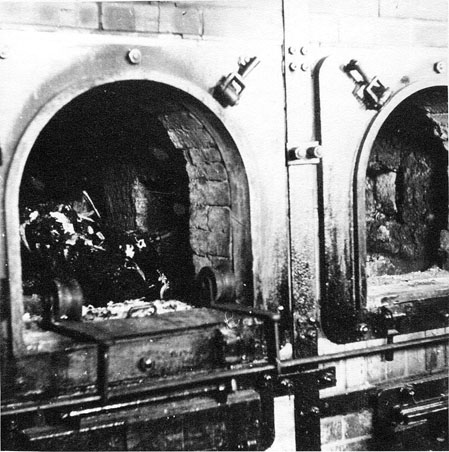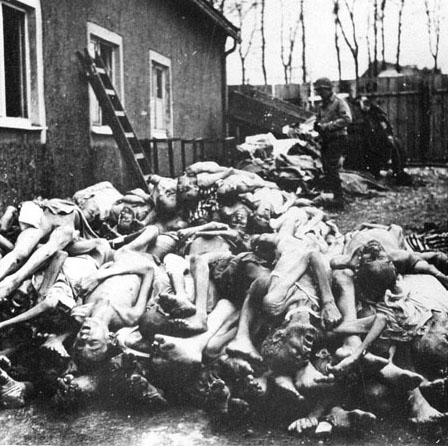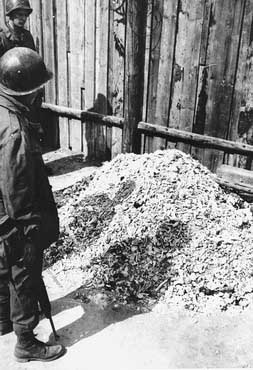First American liberators arrive at BuchenwaldAmong the first American soldiers to enter the Buchenwald concentration camp was First Lieutenant Edward A. Tenenbaum, who spoke "American German," according to The Buchenwald Report. He arrived on April 11th, along with a civilian named Egon W. Fleck, at 5:30 p.m. in an American jeep. The two men stayed in Buchenwald that night in Block 50, the medical building. Fleck and Tenenbaum wrote a detailed report on what their lengthy investigation of the camp had revealed. Alfred Toombs, who was Tenenbaum's commanding officer, wrote a preface to the report, in which he mentioned how "the prisoners themselves organized a deadly terror within the Nazi terror." The following quote from Fleck and Tenenbaum's report describes the power exercised by the German Communist prisoners at Buchenwald: The trusties, who in time became almost exclusively Communist Germans, had the power of life and death over all other inmates. They could sentence a man or a group to almost certain death ... The Communist trusties were directly responsible for a large part of the brutalities at Buchenwald. According to The Buchenwald Report, the bible of the camp written by a special intelligence team of the American Army, led by Albert G. Rosenberg, it was not until Friday the 13th that the rest of Patton's troops arrived, accompanied by Generals Eisenhower, Bradley and Patton. Although the Buchenwald Report says that the three top American generals saw the camp on April 13, Patton himself wrote that it was not until April 14, 1945 that he heard some of the gory details about Buchenwald from General Gay and Colonels Pfann and Codman, who had visited it. Patton wrote in his book that he immediately called General Eisenhower, even before seeing the camp himself, and suggested that he send photographers and members of the press "to get the horrid details." General Dwight D. Eisenhower and General Omar Bradley had visited the Ohrdruf sub-camp of Buchenwald, along with General Patton, on April 12, 1945 but neither Eisenhower nor Bradley ever bothered to visit the Buchenwald main camp. General Patton's impression of the camp being controlled by the inmates was confirmed by Colonel Donald B. Robinson, chief historian of the American military occupation in Germany, who wrote an article for an American magazine after the war about the report of Fleck and Tenenbaum: "It appeared that the prisoners who agreed with the Communists ate; those who didn't starved to death." Other accounts of the liberation of Buchenwald vary. Some of the American soldiers wrote that the ovens were still in operation and that they had to shut them down in order to stop the burning of live prisoners; others wrote that the ovens were cold because there was no fuel and dead bodies were piled up. The American soldier who took the first photo below wrote on the back of the print "some were alive yet." Many American soldiers would later report that they were overwhelmed by the sight of the Buchenwald camp: this was a death factory where the German barbarians were systematically killing innocent human beings by hanging them from meat hooks on the wall, and even burning the victims in brick ovens while they were still alive.  The Germans didn't even have the common decency to clothe the naked bodies, rotting in the sun with their genitals exposed, nor to give these innocent victims a decent burial like human beings. As General Eisenhower later said, if America's soldiers didn't know before what they were fighting for, at least now they knew what they were fighting against. The American soldiers felt very proud that they had arrived in time to stop this unbelievable cruelty before the rest of the prisoners in the camp could be fed into the Nazi killing machine. Even better, they had stopped the ugly bigotry and racism of the Germans before American citizens could be subjected to a similar fate.   Three days later, the 120th Evacuation Hospital arrived in Weimar with a staff of 273 service personnel to take care of 3,000 sick prisoners at Buchenwald; a hospital was set up in the barracks of the SS soldiers who had been stationed at Buchenwald. The staff stayed in a beautiful castle on the Ettersberg, which had formerly been the summer home of German royalty. A path through the woods connected the castle to the concentration camp. One of the soldiers with this unit was Tech. Sgt. Warren E. Priest from Haverhill, MA. In October 2007, Warren Priest told his story to Mike Pride, the editor of the Concord Monitor. The following quote from Warren Priest was included in an article published by the Concord Monitor on October 25, 2007: We left this lovely summer home and walked up a pathway through the woods. It was spring, and the leaves were just emerging. We saw all the loveliness and color of the season. We smelled Buchenwald long before we saw it. That whole area was overwhelmingly and intrusively affected by the odor of death in the camp. You couldn't escape it. Reaching near the top, I suddenly encountered human forms. We had been trained not to fraternize, so I didn't say anything. I held my carbine. They moved to the side of the pathway and got down on their knees and put their hands together prayerfully and looked up and smiled. It was one of those moments when expression was all nonverbal. Buchenwald was a work camp, not a death camp, although plenty had been killed there. Close by was a Karl Zeiss factory, where prisoners worked. They specialized in the assembly of optical instruments - binoculars and cameras. We got quite a few of the things we needed from a supply train that the American troops had captured. We stole, if you will, things from the factory. I had two or three pairs of binoculars and a 35-millimeter camera. The men of the 120th Evacuation Hospital did everything they could to save the victims of the Nazis at Buchenwald, even donating their own blood, according to Warren Priest. I was struck by how little we did
with the training they had spent so much time giving us. What
we encountered was so different from what we were prepared for.
Very little medical work was done by anyone. It was all recovery
type of medical treatment. For example, the best treatment for
dysentery and starvation was whole blood. We all gave blood as
much as we could. The following quote is from Warren Priest's interview with Mike Pride, the editor of the Concord Monitor: After two weeks, we went to Cham to set up a hospital for survivors of Dachau. I had participated in one amputation - a leg - before I got sick. It was typhus. I was treated in the same building, above where the surgery was taking place. If it weren't for sulfa drugs, I wouldn't be here today. Regarding the bomb devastation in Frankfurt, Warren Priest wrote the following in a letter to his mother: Wherever the Germans made a stand, a monumental rubbish pile is the only remaining evidence of civilization. The catastrophic destruction of these German cities will be a terrible restraining element for any future hostile aspirations, believe me. Frankfurt am Main, previously a very gorgeous city, was leveled - literally. All of the sights worth seeing were not to be seen. People were searching scrap heaps for traces of their belongings. But as terrible as it may sound to you, it cannot begin to describe the punishment which should be theirs, and which they have not begun to receive. In the same letter, Priest wrote the following, after seeing Buchenwald: I saw what and why we were fighting. Never never permit yourself to feel any trace of pity whatsoever for the German people, Mum. They've jeopardized their right to call themselves standing members of our world of civilization. They are certainly no better than the Japs, and in some respects worse. The liberated Buchenwald prisoners made
sure that the Americans knew the extent of the atrocities in
the camp. In his interview with the editor of the Concord Monitor,
Warren Priest recounted the following story about Buchenwald: In his letter home to his mother, Warren Priest elaborated on the human skin objects that were found at Buchenwald: I saw lampshades made of patches of human skin - anyone who came to the camp with a tattoo on him evidently didn't enjoy himself quite as much as he might have. The commandant of the post collected these as a hobby, and had lampshades, pictures, even a ship's sails made from human skin. I have that boat now. Ironically, it's called the Santa Maria and has pictures of the Virgin & Child on the sails, with crosses garnished about. Quite a charming fellow, this commandant. The sailboat with sails made from human skin was donated to the U.S. Holocaust Memorial Museum in Washington, DC. German civilians tour BuchenwaldExhibits put up by prisonersMore exhibits at BuchenwaldBuchenwald SurvivorsBuchenwald OrphansOld photos of BuchenwaldCongressmen & ReportersEdward R. Murrow ReportLiberation ClaimsBack to Buchenwald liberationHomeThis page was last updated on December 16, 2007 |